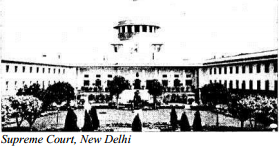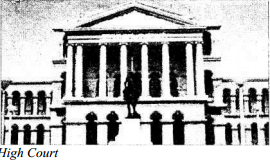Students can Download Political Science Chapter 4 Judicial System Questions and Answers, Notes, KSEEB Solutions for Class 9 Social Science helps you to revise complete Karnataka State Board Syllabus and score more marks in your examinations.
Karnataka State Syllabus Class 9 Social Science Political Science Chapter 4 Judicial System
Class 9 Social Science Judicial System Textual Questions and Answers
I. Fill in the blanks with suitable words.
Question 1.
The Supreme Court of India came into existence in
Answer:
January 28, 1950.
Question 2.
The retirement age of the High Court judge is
Answer:
62 years
![]()
Question 3.
The Judges are appointed by
Answer:
President.
Question 4.
The head of the Revenue Tax Board is
Answer:
Revenue Secretary.
Question 5.
The Lokadalats came into existence in the year
Answer:
1985.
Answer:
Functions of the Supreme Court :
II. Answer the following questions with group discussion:
Question 1.
Explain the functions of the Supreme Court.

Answer:
Resolving the disputes between the Union and State Governments; between the States; safeguarding the Fundamental Rights of citizens; interpreting the provisions granted by the Constitution are the original powers of the Supreme Court.
It also exercises appellate powers and advisory powers. It has the power to accept the appeals made against the judgment given by the lower courts. This is called appellate power. It can advise the President regarding public issues when its opinion is sought. This is called advisory power. It also serves as a court of records, chief advisor to the center, and state governments and also issues special writs.
![]()
Question 2.
Write a note on the functions of High Courts.
Answer:
The functions of the High Court are :

- High courts can take up civil and criminal cases. It can also handle eases related to marital relationships, contempt of courts etc.
- It can admit appeals in civil and criminal cases from the subordinate courts.
- It can transfer cases from the lower courts to the high court.
- It can supervise the work of the subordinate courts.
- It can admit writ petitions to safeguard the fundamental rights and other legal rights of the citizens.
Question 3.
Name the subordinate’s courts under the civil courts.
Answer:
The subordinate courts under the District Court :
- Court of Subordinate Judges,
- Court of Additional Subordinate Judges
- Court of Munciffs.
- Court of Additional Munciffs.
Question 4.
Write a note on Criminal courts.
Answer:
Criminal courts are also known as District Magistrate courts. They function under the High Court. The highest criminal court at the district level is the Sessions court, “the district judge performs the function of a judge of this court too. The court takes up crimes like murder, robbery, dacoity, etc. It has the power to issue death sentences and also life imprisonment sentences. However, such sentences will have to be ratified by the High Court. Similarly, an appeal may be made to the High Court against the judgments given by the criminal court.
Question 5.
Write a note on Revenue Courts.
Answer:
There are Revenue courts in every district. They take up cases related to land tax, land records, etc. Revenue Courts comprise the following courts:
- Tahasildar Court :
The Tahasildar Court is the lowest court among the Revenue courts and the Tahasildar is its judge. This court is also known as Taluk Magistrate Court. - District Sub-divisional Officer’s Court:
The Assistant Commissioner is the judge in this court. This court takes up appeals against the decisions and judgments of Tahasildar courts. - District Revenue Court or District Magistrate Court :
Existing in every district, this court takes up appeals against the judgments given by the Tahasildar court or the District Sub-divisional Officer’s court. The Deputy Commissioner is its judge. - Commissioner’s Court :
This court takes up appeals against the judgments of the district magistrate courts. The Divisional Officer is its judge.
![]()
Question 6.
What are the reasons behind the establishment of Lok Adalat Court?
Answer:
In India, the legal procedure is time-consuming and expensive. As an alternative, the Government has set up other forms of legal institutions that function faster and are less expensive. These institutions came into existence in 1985. One of them is Lok Adalat. It takes up cases from parties who mutually agree to settle the cases amicably. Cases that have not yet been disposed of by the other courts or the High Court can be settled by the Lok Adalats. The judgments given by the Lok Adalats are final and binding on both the parties and appeals cannot be filed against them.